Cordyceps – the Himalayan Tonic for Vitality
Cordyceps sinensis, often hailed as a jewel in the crown of traditional Tibetan and Chinese medicinal practices, stands out for its unique combination of a caterpillar and a fungus. This extraordinary entomopathogenic fungus, thriving in the high altitudes of the Himalayan regions, has captivated the attention of the medical world due to its array of purported health benefits. In this blog, we will embark on an enlightening journey to explore the enigmatic world of Cordyceps. We’ll delve into its intriguing lifecycle, historical significance, and the growing body of scientific research investigating its potential as a natural therapeutic agent. From its traditional roots as a remedy for a variety of ailments to its current status as a subject of modern medical research, Cordyceps presents a fascinating intersection of ancient wisdom and contemporary science.
The Unusual Cordyceps Sinensis – A Journey from the Himalayas to Your Health
Cordyceps, also known as the caterpillar fungus, is a unique species of parasitic fungi that has piqued the interest of scientists and health enthusiasts alike. This post will take you on a journey through the life cycle of this fascinating fungus, from its growth in the high mountains to its harvest and use in traditional medicine.
The High Altitude Home of Cordyceps
 Cordyceps is not your average fungus. It grows exclusively on the larvae of ghost moths, found in the high-altitude regions of the Himalayas, between 3,500 and 5,000 meters (about 11,500 to 16,400 feet). This makes the Himalayan mountains, including regions such as Tibet, Nepal, and India, a popular harvesting spot for this valuable fungus.
Cordyceps is not your average fungus. It grows exclusively on the larvae of ghost moths, found in the high-altitude regions of the Himalayas, between 3,500 and 5,000 meters (about 11,500 to 16,400 feet). This makes the Himalayan mountains, including regions such as Tibet, Nepal, and India, a popular harvesting spot for this valuable fungus.
What’s In a Name
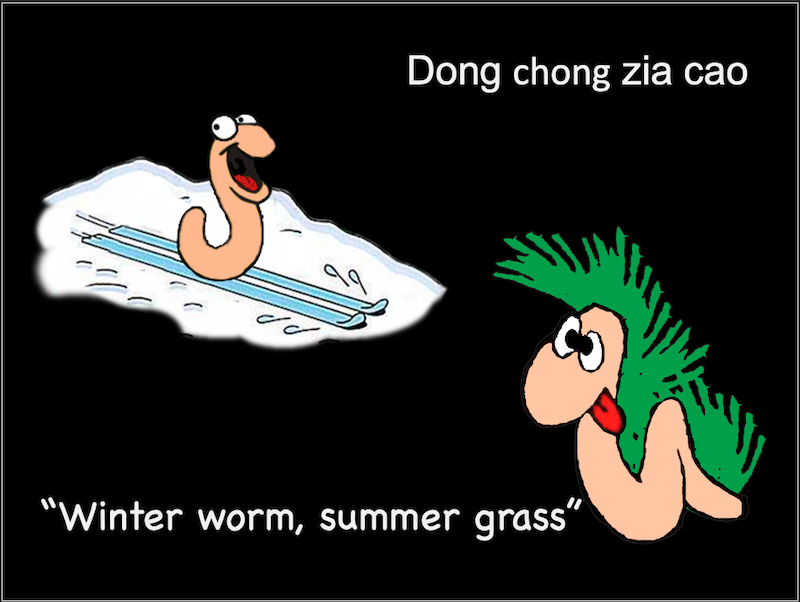 Cordyceps is known in Chinese as “dōng chóng xià cǎo”. (冬虫夏草), which translates to “winter worm, summer grass”. This name reflects the unique life cycle of the Cordyceps fungus. In the wild Cordyceps grows in the Himalayas from the moth larvae. During the winter, the fungus invades and consumes the body of larvae – hence the “winter worm”. By summer the fruiting body of the fungus emerges from the consumed insect, resembling a blade of grass – hence the “summer grass”. This transformation from “worm” to “grass” is how it got its name “dōng chóng xià cǎo”. The name is sometimes abbreviated to chong cao, meaning “insect plant and is generally applied to other species of Cordyceps as well.
Cordyceps is known in Chinese as “dōng chóng xià cǎo”. (冬虫夏草), which translates to “winter worm, summer grass”. This name reflects the unique life cycle of the Cordyceps fungus. In the wild Cordyceps grows in the Himalayas from the moth larvae. During the winter, the fungus invades and consumes the body of larvae – hence the “winter worm”. By summer the fruiting body of the fungus emerges from the consumed insect, resembling a blade of grass – hence the “summer grass”. This transformation from “worm” to “grass” is how it got its name “dōng chóng xià cǎo”. The name is sometimes abbreviated to chong cao, meaning “insect plant and is generally applied to other species of Cordyceps as well.
The Life Cycle of Cordyceps
The life cycle of Cordyceps is as fascinating as its medicinal properties. The textured surface on the club of the stroma releases spores, which are distributed into the surrounding environment. These spores then colonize new larval hosts, continuing the cycle of this unique parasitic relationship.
Harvesting the Gold of the Himalayas
Wild Cordyceps is a powerful health supporting fungus that grows off the ghost moth caterpillar in rich Himalayan soil at altitudes above 3,800 meters. It is the world’s most expensive biological resource and can be sold as high as US$ 27,000 per kilo. Cordyceps hunters have to dig through the grass on their hands and knees, and on a good day they may collect only 3 or 4 Cordyceps. 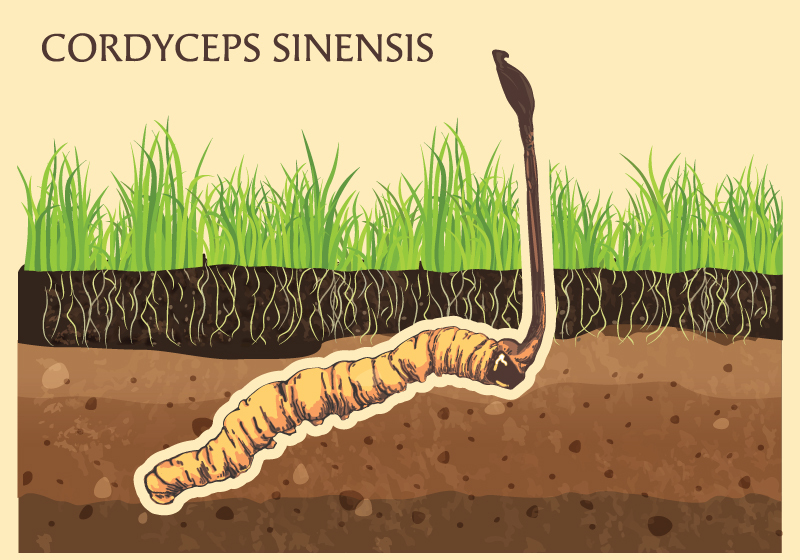 Please keep in mind that it is probably best to avoid buying wild Cordyceps because of the environmental damage associated with its harvesting. Also, because its high value, there has been a tendency for adulteration, sometimes sticking wire inside the caterpillar to make it weigh more.
Please keep in mind that it is probably best to avoid buying wild Cordyceps because of the environmental damage associated with its harvesting. Also, because its high value, there has been a tendency for adulteration, sometimes sticking wire inside the caterpillar to make it weigh more.
Cultivation: A Sustainable Alternative?
While cultivation techniques for Cordyceps fruiting body have been developed, they are not an economically viable option for large-scale production. The cultivation of mycelium by means of a fermentation process is now widely used, ideally with the well-researched high-potency strain called “CS-4”. Thankfully the research supports the use of fermented Cordyceps with studies finding that it yields a similar chemistry as well as offering similar health supporting benefits. (Note: Mushroom Wisdom uses the CS-4 strain that is grown by fermentation.)
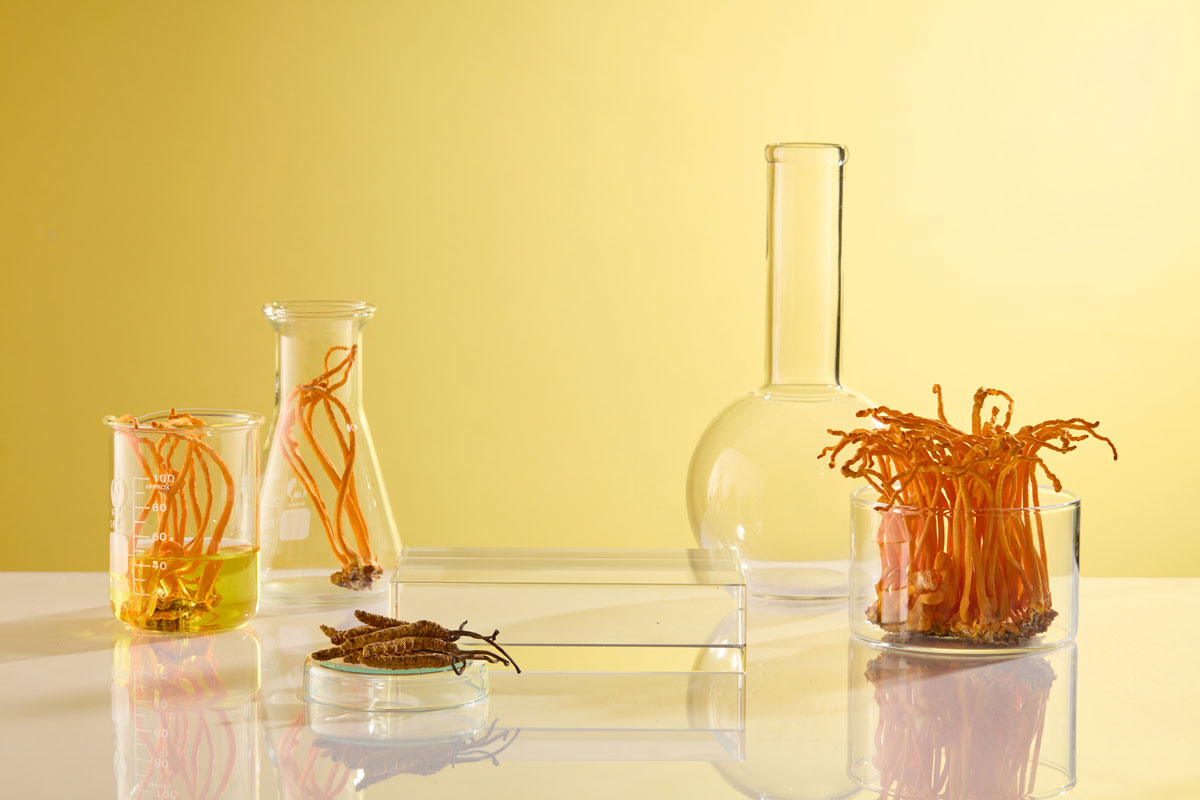
Cordyceps, the Yin and the Yang of it
In traditional Chinese medicine (TCM), the concepts of Yin and Yang are fundamental to understanding the body’s balance and health. Yin and Yang are seen as opposite yet complementary forces that need to be in harmony for optimal health.
Cordyceps, in TCM, is believed to have unique properties that can both boost Yang and nourish Yin, making it a valuable and balanced tonic ally.
Boosting the Yang: Yang in TCM represents active, warm, and dynamic functions in the body. It’s associated with energy, movement, and the functioning of internal organs. Cordyceps is said to boost Yang by increasing energy levels, enhancing stamina, and improving the function of organs like the kidneys and lungs. This is often interpreted in modern terms as increasing ATP production (the molecule that stores and transfers energy in cells) and enhancing oxygen utilization, which are crucial for physical energy and vitality.
Nourishing the Yin: Yin, on the other hand, is associated with cool, passive, and nurturing aspects. It is linked with fluids, nourishment, and the substance of the body, like blood and tissues. Cordyceps is believed to nourish Yin by helping to maintain adequate hydration, nourish the body’s tissues, and support vital fluids. This aspect is often correlated with its potential anti-aging properties, support for immune function, and potential to help in recovery from illness or fatigue.
The balance of Yin and Yang is crucial in TCM, and substances like Cordyceps that are believed to influence both are highly valued. This dual action is thought to make Cordyceps especially beneficial for overall health, vitality, and wellbeing, as it is said to bring balance to the body’s systems.
In modern terms, the benefits attributed to Cordyceps, such as increased energy, improved immune function, and longevity supporting activities, can be partially explained by its content of bioactive compounds like cordycepin, polysaccharides, and vitamins which have various health-promoting properties. However, it’s important to note that while there is a growing body of scientific research supporting these benefits, much of the understanding from a TCM perspective is based on traditional use and theory rather than empirical scientific evidence.*
Cordyceps – a General and Specific Tonic
 The word “tonic” is a term that I think is often found confusing, so let’s start off by defining that I mean by tonic: A tonic remedy is a type of preparation or substance that is traditionally used to promote and support overall health, vitality, and well-being. Tonic herbs are often considered as a means of enhancing the body’s vitality, resilience, and longevity. Here are some key characteristics and features of tonic herbal remedies: best used long-term, balancing, adapting to stress, supports vital organs and systems, enhances vitality, builds energy, supports immune system, supports healthy aging, and enhances prevention. Cordyceps fits this bill perfectly nourishing overall health and vitality while supporting specific systems and organs.*
The word “tonic” is a term that I think is often found confusing, so let’s start off by defining that I mean by tonic: A tonic remedy is a type of preparation or substance that is traditionally used to promote and support overall health, vitality, and well-being. Tonic herbs are often considered as a means of enhancing the body’s vitality, resilience, and longevity. Here are some key characteristics and features of tonic herbal remedies: best used long-term, balancing, adapting to stress, supports vital organs and systems, enhances vitality, builds energy, supports immune system, supports healthy aging, and enhances prevention. Cordyceps fits this bill perfectly nourishing overall health and vitality while supporting specific systems and organs.*
The Traditional Use of Cordyceps in Traditional Chinese Medicine
Cordyceps, a type of fungus, has been a cornerstone of Traditional Chinese Medicine (TCM) for centuries. Interestingly, recent scientific explorations of Cordyceps have generally tended to support its traditional uses. This unusual fungus was used for a wide array of applications, some of which are:
Energy and Strength
One of the most common uses of Cordyceps in TCM was as a natural energy booster. It was believed to increase the body’s production of the molecule adenosine triphosphate (ATP), which is essential for delivering energy to the muscles. This made Cordyceps a popular remedy among the elderly and athletes.*
Immunity
Cordyceps was also used to enhance the immune system. It was believed to have the ability to support the body’s natural defenses, making it a valuable tool in maintaining overall health.*
Kidney Function
Supporting healthy kidney function was another historical use of Cordyceps as it was often used in traditional Chinese medicine.*
Respiratory Health
Cordyceps was used to support and strengthen respiratory system function. Key to this activity are its actions supporting a healthy inflammatory response which were believed to have a beneficial effect on the respiratory tract.*
Sexual Dysfunction
Lastly, Cordyceps was used to combat sexual dysfunction. It was often prescribed as a natural aphrodisiac and was used to support the overall health and function of the reproductive system in both men and women.*
In ancient China, Cordyceps was so highly valued that it was exclusively available to the imperial court. Traditionally, the fruiting body of cordyceps was ground down and cooked with tea and other herbs.
Cordyceps – a General and Specific Tonic
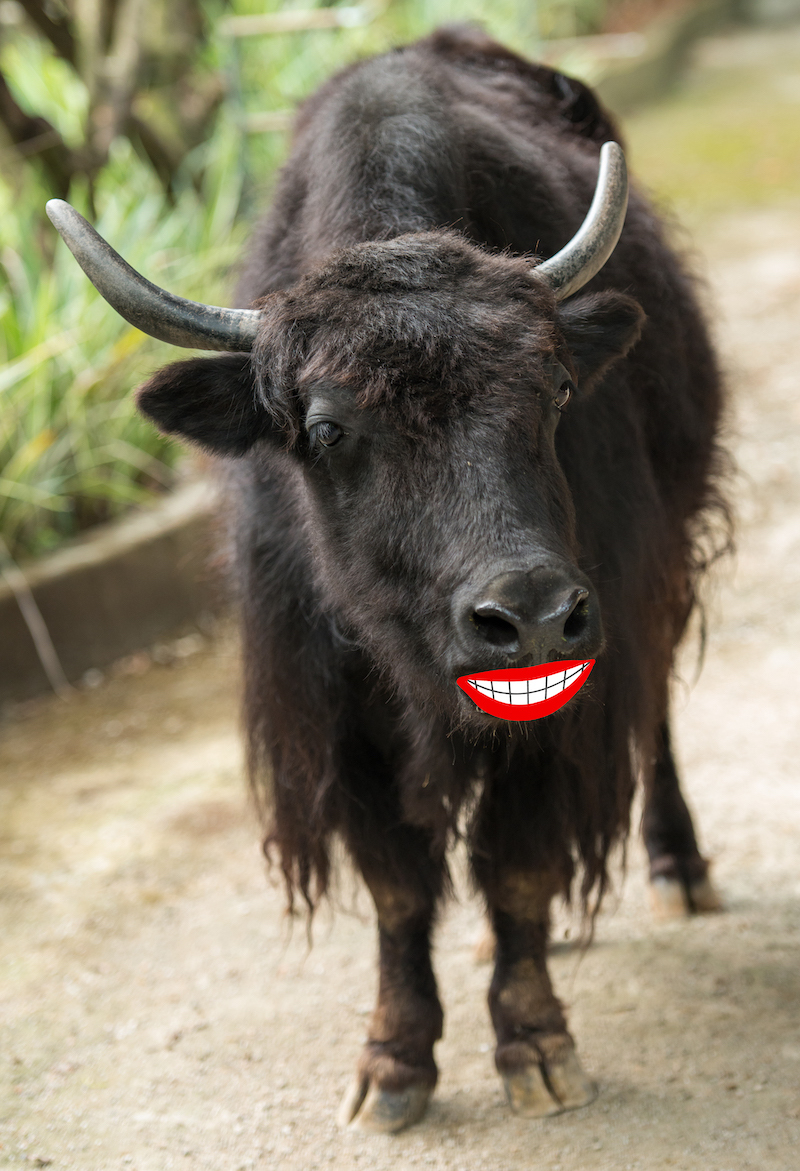 In the Himalayan Mountains Yak were brought to higher grounds in the spring to feed on the fresh grasses. Once there, herders noticed that the Yak would selectively graze in the new grass, looking for something specific. Upon finding and eating whatever it was they were looking for, they became “friskier”. Turns out, they were eating Cordyceps (Cordyceps sinensis).
In the Himalayan Mountains Yak were brought to higher grounds in the spring to feed on the fresh grasses. Once there, herders noticed that the Yak would selectively graze in the new grass, looking for something specific. Upon finding and eating whatever it was they were looking for, they became “friskier”. Turns out, they were eating Cordyceps (Cordyceps sinensis).
Word got around, and it eventually travelled to the Imperial Court where it became a highly prized and exclusive remedy amount the royalty with a reputation for increasing “friskiness”.
Thus, the fame of this “Yakodisiac” came to be.
Yes, there is some research suggesting that Cordyceps might have potential benefits for sexual dysfunction*:
Libido Enhancement: Studies suggest that Cordyceps might boost libido due to its potential effects on testosterone levels and blood flow.*
Erectile Dysfunction: A study found that Cordyceps extract had significant libido promoting activity when administered to male rats. Notably, diabetic rats that typically experience erectile dysfunction showed increased penile erection function and sexual behavior after administering Cordyceps.*
Female Sexual Dysfunction: Other studies focused on the impact of Cordyceps on female sexual dysfunction. Research indicated that the Cordyceps supplement might positively affect estrogen levels, thereby influencing reproductive function and potentially alleviating symptoms of female sexual dysfunction.*
Sperm Quality: Cordyceps supplementation has also been found to improve sperm quality and quantity in rats.*
Unusual, But a Promising Ally
Cordyceps sinensis stands as a testament to the wonders of the natural world and the enduring legacy of traditional medicine. Its complex life cycle, unique biological characteristics, and the potential health benefits it may offer, continue to intrigue and inspire both the scientific community and wellness enthusiasts alike. As we’ve explored in this blog, the journey of Cordyceps sinensis from the high-altitude meadows of the Himalayas to the shelves of health stores worldwide, is a remarkable story of cultural significance, scientific curiosity, and potential therapeutic promise. From enhancing exercise performance and immunity to supporting a healthy inflammatory response and healthy aging, Cordyceps may offer a natural way to improve your well-being. While further research is needed to fully understand and harness this traditional tonic, Cordyceps sinensis undeniably remains a symbol of the delicate balance between nature and health, offering an unusual beacon of hope and healing in the world of natural remedies.*
